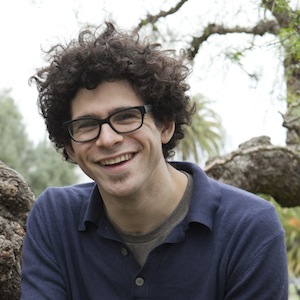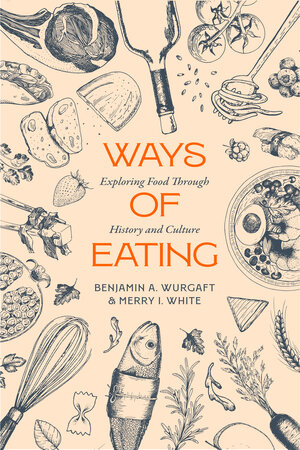

Wurgaft and White—son and mother—make delightful company as they guide us through everything from the birth of agriculture to the lamination in a croissant in modern-day Tokyo.
From the origins of agriculture to contemporary debates over culinary authenticity, Ways of Eating introduces readers to world food history and food anthropology. Through engaging stories and historical deep dives, Benjamin A. Wurgaft and Merry I. White offer new ways to understand food in relation to its natural and cultural histories and the social rules that shape our meals.
Merry I. White is Professor of Anthropology at Boston University. Her previous books include Coffee Life in Japan and Perfectly Japanese: Making Families in an Era of Upheaval. The Japanese government has honored her work in the anthropology of Japan with the Order of the Rising Sun.
Benjamin A. Wurgaft is a writer and historian. His previous books include Meat Planet: Artificial Flesh and the Future of Food and Thinking in Public: Strauss, Levinas, Arendt.
Ways of Eating is a unique mother-son authorial collaboration. How did the idea to work together on this book come about, and what was the process like in terms of combining your distinct expertise and perspectives? Could you share a bit about the journey that led to the creation of Ways of Eating?
Ben: Over a decade ago, someone suggested that Corky might write a short introductory book about world food history – and she decided that as an anthropologist, she might invite her son, who had just finished his doctorate in history, to join her. Over the years we moved away from the idea of a comprehensive “global” history, both because it was too unwieldy and because of our feelings that efforts at exhaustive global history inevitably simplify things too much. Inspired by John Berger’s 1972 Ways of Seeing, a landmark in art criticism which brought Marxist elements of social and political criticism to the general public in Britain and the US, we called our book Ways of Eating, and focused (as Berger had done) on techniques – the result is a book that combines the fundamentals of world food history with the observational practices of food anthropology. As for how we worked – well, we’re very different kinds of scholars! Corky is an ethnographer par excellence, and can offer stories and insights from work all over the world, and I (Ben) am more theoretically inclined, and even though I’ve often worked as a food writer, my doctorate is in European intellectual history, rather than food history. Finding a way to make our strengths complimentary, that was the trick. We divided up the chapters, edited each other’s work, and talked over each sentence.
Corky: Anthropologists love social history, cultural change, events that actually change culture – we’re not so far from historians… and we are good at stories, we listen and create contexts for people’s stories, and for our own observations. We’re participant observers – Malinowski set the pattern for field work in this mode. But I as an anthropologist am a bit far from theory; I like the stories and I let them muster up meaning.
We took on different chapters at first – according to interests and experiences: I really wanted to treat “modern” empires because I was interested in the British Empire and its particular relationship with its colonies, for example.
I have been a food-focused scholar-writer-practitioner for over 60 years and though academe didn’t always appreciate it, I’ve found my interest and scholarship in food finally accredited. The story of how that went is an interesting and revealing one – how body and mind, hand and brain work, for a long time were separated, and gendered, and how at last I have come out of the (kitchen) closet.
Were there unexpected benefits to working as mother and son?
Ben: Certainly! First off, we’ve shared many experiences that turn up in the ethnographic vignettes, and we each could contribute a different perspective on them – as in our visit to Chichibu Distillery outside Tokyo, which we describe in the book. I also think that we’ve enjoyed the personal benefit of learning more about each other as thinkers, about each other’s tastes, our likes and dislikes.
Corky: We learned each other’s practices and preferences. Taking on different chapters and then trading them for editing, ideas and voice was really interesting, both to see what we knew and didn’t know about the other person and how we then collaborated to meet in the middle. We also learned patience and compromise.
One point of not-quite-contention was about the inclusion of recipes – or not. I wanted to bring in practice, to show what you learn about food by cooking it, and to give recipes their due as texts illustrating many things – the science of measurement, the varied vernaculars of recipe composition, etc. That some of our favorite books had recipes – The Debt to Pleasure and Nora Ephron’s Heartburn, to name a few.
Can you give a sneak peek into one of the most surprising discoveries you made while researching the book?
Ben: One surprise that we’d like readers to appreciate, is how recently, in historical terms, current food practices have taken shape. Certainly, some things, like the range of grains we cultivate, are quite old, but other things, including the ingredients in Chinese or Italian noodle dishes that seem timeless, actually came together only in the last few hundred years. This isn’t a “discovery” we made, it’s a lesson of food history, and we need this lesson because the idea of timeless or “authentic” foods gets thrown around with abandon.
Corky: When you learn that some foods were taboo and then became staples, when you find dishes you’d never heard of and run to the kitchen to make them. That foods have always moved, and it’s a rare ingredient that doesn’t appear in many places at once. When you consider that some foods have taken on “protected” status as “national” or “controlled” – designation controllee, etc. So an actual technique, set of ingredients comprise an “authentic” version. I particularly love that Tokyo has more certifications from the Associazione della vera pizza napoletana, based in Naples, than any other city. Why these things matter, rather than whether there IS a “true” Neapolitan pizza, is of interest.
Were there any surprising commonalities you discovered among diverse societies when it comes to ways they approach and value food?
Corky: That there are concerns connecting diverse places about food as health, environment & sustainability, worker welfare, equity of distribution, etc. but that they are played out differently perhaps – Slow Food in Italy and other places, resistance to industrial food (Bove, etc.), anti-GMO in some places, free school lunch programs, etc. That there are different ideas of what constitutes a meal – a dish, an ingredient, techniques. That at first in Japan a McDonald’s burger could not be a meal – there was no rice in it. That staple foods vary considerably. That foods which are seemingly forever “local” – such as tempura in Japan – are actually from somewhere else – Portugal. That eating “before contact” in Hawaii is considered vastly healthier than eating “after contact,” though these denominators are tricky to define.
Were there any surprising historical food trends you encountered that seem to have cyclically resurfaced or significantly impacted modern eating habits?
Corky: Vegetable-heavy, meat-thin menus/diets; ideas about the healthy body and thoughts of what are good for you. Think coffee, now acclaimed by heart specialists and others as very good for you… as it had been in Japan when at first it was considered medicinal, a soporific!
How does your book contribute to our understanding of how food shapes and reflects cultural identities?
Ben: Whether it’s ramen or injera, pizza or sausage, the idea of “national food” is everywhere, and sometimes seems to defy the idea that we live in a post-national world. But our book argues against the high valuation of “authenticity.” One way to phrase our argument is that “authenticity” is only real because people keep using the word, implying that they believe in something called authenticity – the word has a social value, and tells us something about the people who use it. But it doesn’t relate to any absolute quality that a pie has, or that barbecue sauce has, or that a bowl of pho has, in part because these things change over time, just like the microorganisms in a sourdough starter change over time. Indeed, the fetish for authenticity can cover what the literary critic Edward Said once called “orientalism” – as when white customers at a sushi restaurant avoid the part of the counter worked by a white sushi chef, because they doubt he will be able to produce “authentic” sushi. We wish people would talk less about what foods are authentic, and more about the economic and social conditions under which people labor to cook for each other.
Corky: How we all care about food: it’s never “just food” – but how identity in many ways is reflected in food – gender, social class, culture, community, regional, national identities… There is no single “Japanese food” menu, nor “Italian” – it sometimes plays out as dialects -regionally, community-based, sub-dialects -family-focused, or even idiolects – a pattern and meaning given to an individual’s “way of eating.”
Here there’s much to say about the cultural anxieties that lead to the hunt for authenticity, and where I tell my students, the important thing to consider is why it is important, to whom, and with what outcomes? If it’s their grandmother who says her food is authentic, you better agree… never question a grandmother!
Food trends and habits have evolved significantly over time. In Ways of Eating, do you highlight any historical examples where societal changes or events had a profound impact on the ways people approached their diets and eating habits?
Ben: The easy answer to this question is that, thus far, two technical developments have been most important: the slow adoption of sedentary agriculture, and the industrialization of agriculture. The former likely gave rise to complex forms of social organization and certainly the first cities, and practices like taxation – it effectively reshaped human sociability. The latter transformed food by making it more plentiful, more predictable in its material properties, and eventually easier to preserve over time; it also contributed to the availability of foods out of season and far from their places of production. And industrial foodways eventually contributed to the incredible population growth we’ve seen in the twentieth century.
Corky: I remember that in the 1970s, Diet for a Small Planet really made waves… Ben’s high school assigned it to first-year students and many went vegetarian upon reading it. I still talk about it in class. Then there was Eric Schlosser on meatpacking plants, a latter-day Upton Sinclair. Anthony Bourdain in Kitchen Confidential making you think about what goes on in a restaurant kitchen. Wartime always affects eating practices, and creates the need for flexibility and restraint. Pandemic eating. We discuss how industrialization affected food practices, technologies in the kitchen. We speak of how industrial food is not ipso facto “bad” food: how to support the world’s population without it?? How body images affected esp. women’s eating habits, changing over time. Remembering also that allergies have a history and also the accommodation of them. Family meals have changed, as has the role of the family cook(s) in the kitchen. The effect of cookbooks – generations of the Joy of Cooking; the Julia Child phenomenon (and here Corky has particular stories as Julia was at her elbow when she was a caterer – literally, not figuratively at the elbow)
Could you discuss any instances where cross-cultural interactions led to the adoption of new culinary practices, as highlighted in your book?
Corky: Colonization, wars, creation of colonial plantations spreading the use of sugar and tea for British people particularly. The creation of modern shipping, the spice trade. Modern wars, universalizing things like canned and dried milk, or spam. MREs have sometimes become industrial products in domestic kitchens. How coffee came to Japan early through Portuguese missionaries, how they also brought tempura and “pan” (bread) to Japan, in early 1600s. Some foods localize and take on local uses and flavors, others stay “exotic.” Columbian Exchange illustrates the HUGE effect the transatlantic movements of food had – and revealed that the old world “borrowers” (Europeans) had disdain or ignorance of New World techniques and practices for such foods as corn and thus, without the indigenous method of nixtamalization needed to protect people from vitamin deficiency diseases, many in Europe died.
In your research, did you come across any rituals or traditions related to food that had an unexpected or lesser-known historical significance?
Ben: Our book’s title is “Ways of Eating” and we want to emphasize this literally. Following the work of Margaret Visser and Bee Wilson, we think that the tools we use to bring food to our mouths have an important and under-studied place in food history and anthropology – there’s all the difference in the world between using a knife at the table to carve meat, and having the partitioning done in the kitchen beforehand, for example, changing the all-important ritual of sharing. Chopsticks, which can pick up tiny bits of food, are a natural fit for wok-cooking, and wok-cooking is a natural fit for the historical scarcity of cooking fuel in many parts of China – so you can see how ways of eating relate to larger food systems, and to the material affordances and limitations of those systems.
Corky: There is SO much variation in when, what and how people eat – chopsticks and their economic function, eating light at the end of the day instead of heavy, the whole material culture of a kitchen batterie de cuisine… I recently mounted an exhibition of Japanese culinary tools – utensils of all sorts, as function and form, “the beauty of use” … we talk about knives in particular. Knives by the way, used to eat peas in the UK, represent an odd use of a common item. Rituals of cleanliness, rituals of sharing, who is served first at the table – and who ends up eating in the kitchen: every aspect of the universal act of eating has had attached to it regional, local, distinct and historically changing practices that make the universal very diverse and particular.
Can you discuss a specific food item or dish that has undergone transformation in its symbolism and significance over time?
Ben: Bread is an easy one – in our book we point out that white bread, particularly, was once a mark of luxury and wealth, because it’s made with flour that, in pre-industrial times, was very difficult to grind to the purity reflected in white bread. And now white bread, particularly industrially produced, spongy white bread, often gets associated with bad health, and with the disease burden carried by poor people in the developed world.
Corky: We speak of coffee, at first seen as useful in religious ritual, then as medicinal (as a cure for insomnia!) then, in Ethiopia, as a ritual act of hospitality, and elsewhere as a seditious pleasure… and how much ideas about health and body maintenance are changing about almost any item – coffee in particular. Milk is another such. We also speak of beer, and the “alewife” whose beer-making function was co-opted by the church, and how its use as a healthier beverage was employed in families for their children.
Could you share a particularly memorable anecdote or story from the book that demonstrates how a specific dish or ingredient encapsulates the essence of a particular historical moment or cultural shift?
Corky: The Columbian Exchange seen in Korean food – before and after. The idea of “pre-contact” foods in Hawaii as being more indigenous, and a diet was invented to correct for the ill health created by “mainland” foods.
Is there a particular narrative or story that stands out to you as particularly poignant or emblematic of the book’s themes?
Corky: The story of Duccio Fantani’s “garden” of encouraged herbs, Edenic, and demonstrates a moment in human cultivation both ancient and contemporary.
What do you hope readers will take away from Ways of Eating? How might your book influence the way people think about and engage their own food choices?
Corky: As MFK Fisher said, “first we eat then we do everything else.” But we reverse that and think about all the “everything elses” we do before we sit down to eat… and what meanings and transformations we attach to them. What are the choices and things that are “good to think” as we move the fork or the chopstick to our lips?
